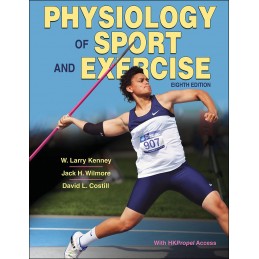Physiology of Sport and Exercise, Eighth Edition With HKPropel Access, continues its legacy as a top physiology textbook and favorite of instructors and students alike. Combining research with extensive visual aids, this resource offers a simple way for students to explore the body’s response to various types and intensities of exercise and sports.
Written by a team of distinguished researchers, all past presidents of the American College of Sports Medicine, this eighth edition has been updated based on the most recent standards and guidelines in the field of exercise physiology. The text builds upon the previous edition’s high standards for illustrations, photos, and medical artwork with a refreshed, more sophisticated look to encourage a deep understanding of complex topics. Multimedia components delivered through HK
Propel include 26 animations that offer a dynamic way to experience physiological concepts and 66 audio clips that offer explanations of elaborate physiological processes. Leaders in the field help students connect theoretical and practical concepts in 27 video clips. Learning assessments and key term flash cards offer additional interactive opportunities to explore the content, and QR codes throughout the text notify students when complementary digital components are available.
Physiology of Sport and Exercise, Eighth Edition, features the following enhancements based on the latest research in the field::
- Additional information on cellular signaling and molecular adaptations
- Expanded content on obesity and sports nutrition
- Reorganized and expanded chapters on energy expenditure and exercise prescription that make the content more accessible to students
- Extensive updates on important topics, including bioinformatics and big data, reading research articles, molecular mechanisms of increased protein synthesis, muscle cramps, and mitochondrial oxidation
- Updated Research Perspective sidebars that emphasize emerging findings in the field and a Research Perspectives Finder to help students locate key content quickly
As in previous editions, readability and ease of understanding make
Physiology of Sport and Exercise different from other physiology resources. Unique learning aids, including chapter-opening outlines and review boxes throughout each chapter, will help students focus on the major concepts addressed. Study questions and a list of key terms at the end of each chapter provide opportunities for recall and self-assessment. A comprehensive glossary and lists of common abbreviations and conversions provide easy reference for students.
Physiology of Sport and Exercise has been a pivotal textbook in the field of exercise physiology. Through this edition’s dynamic and interactive learning activities, easy-to-follow layouts, and research-oriented content enriched with visual supplements, students and instructors will find this an invaluable resource for their continued education.
Note:: A code for accessing HK
Propel is included with this digital version.


 Dostawa
Dostawa
 Płatność
Płatność
 Zwroty
Zwroty
